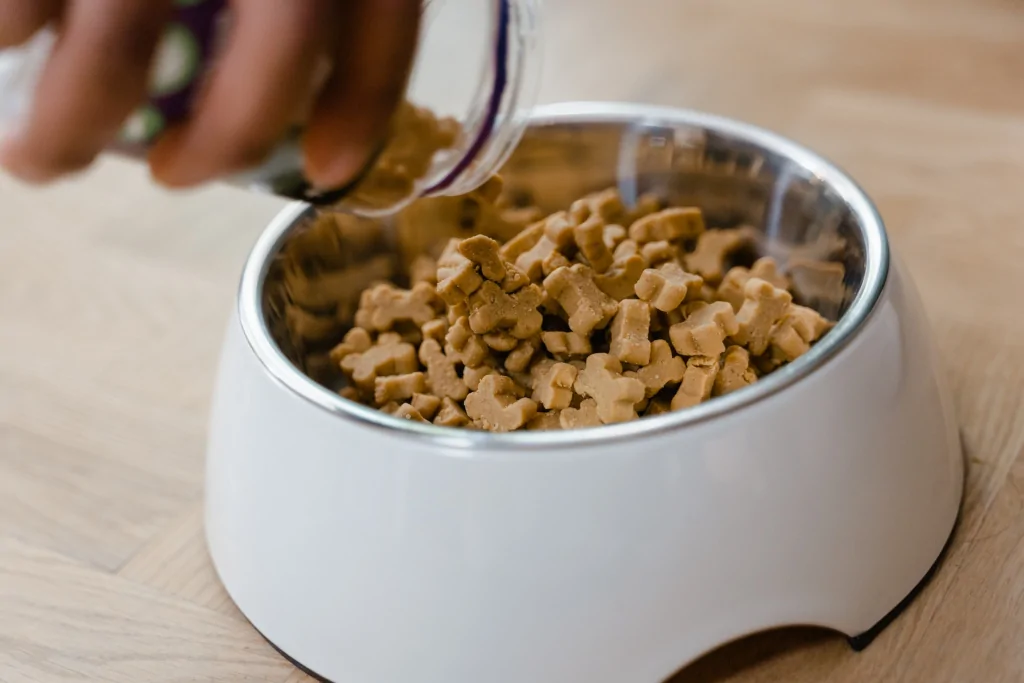Note: We may earn a commission from helpful, relevant links in our content. No cost to you. See our privacy policy.
Ever wondered what your dog’s food tastes like, and if it’s actually enjoyable for them? You’re not the only curious pet parent out there.
As we dive into the world of dog food flavors, we’ll explore what makes kibble tasty for our furry friends and how it might taste to their human counterparts. Join us as we uncover the secrets behind the kibble.

Dog Food Flavors: What’s Inside the Kibble?
The variety of dog food flavors available today is vast. From chicken to beef, salmon to lamb, there’s a flavor for every canine preference.
These flavors are achieved through a combination of real meat, vegetables, grains, and other ingredients that not only provide nutrition but also create a taste that appeals to dogs.
Kibble also contains various vitamins, minerals, and antioxidants, ensuring a balanced and complete meal for your furry friend.
How Does Dog Food Taste to Humans?
For humans, dog food might not taste as appetizing as it does to our furry friends.
Due to our more sensitive palates, we might find dog food to be bland, slightly bitter, or even a bit gritty in texture.
Keep in mind that dog food is specifically designed to cater to a dog’s taste buds and nutritional needs, which are different from ours. While it may not be a culinary delight for us, our dogs certainly seem to enjoy it!
Interestingly, there are some foods that can basically act as human kibble, since they contain all the basic ingredients, vitamins, and minerals humans need. But these are still not even closely similar to the actual dog kibble, just that they satisfy human basic needs.
Ingredients That Make Dog Food Taste Good (Or Bad)
What makes dog food taste good or bad largely depends on the ingredients used in the formulation.
High-quality, real meat ingredients like chicken, beef, or fish can make dog food more appealing to dogs, thanks to their natural flavors and aromas. Vegetables and grains can also contribute to a well-rounded taste profile.
Conversely, low-quality ingredients, such as meat by-products, artificial flavors, or excessive fillers, can make dog food less appealing to dogs. These ingredients might be less nutritious and can lead to a less enjoyable eating experience for your pet.
To ensure that your dog enjoys their food and receives proper nutrition, it’s important to choose a dog food made with high-quality, natural ingredients.
Processing Methods and Their Impact on Taste
The way dog food is processed can have a significant impact on its taste. There are several processing methods commonly used in the pet food industry, each with its own effects on flavor:
- Extrusion. This is the most common method used for producing dry dog food (kibble). The ingredients are cooked under high pressure and temperature, then forced through a machine called an extruder. This process can enhance the taste of dog food by creating a more consistent texture and preserving the natural flavors of the ingredients.
- Baking. Some dog foods are baked, which can result in a crunchy texture and a richer, more aromatic flavor profile. However, baking may cause some loss of nutrients due to the high temperatures used.
- Canning. Wet dog food is typically produced using a canning process, which involves cooking the food in a sealed container at a high temperature. This method helps to retain moisture and can result in a more intense, meaty flavor that many dogs find appealing.
- Freeze-drying. This process involves rapidly freezing the dog food ingredients and then removing the moisture under a vacuum. Freeze drying retains most of the food’s nutrients and natural flavors, resulting in a highly palatable product that’s lightweight and easy to store.
Armed with the knowledge of how various processing methods affect taste, you’ll be better equipped to choose the ideal dog food that caters to your pet’s taste preferences while meeting their nutritional needs.
Flavor Enhancers: What Are They and How Do They Work?
Flavor enhancers are substances added to dog food to improve its taste and aroma, making it more appealing to your furry friend.
These additives can be natural or synthetic, and they work by either intensifying the existing flavors or masking undesirable tastes. Common flavor enhancers in dog food include:
- Animal digest. A concentrated liquid or powder derived from the enzymatic breakdown of animal tissues. This natural flavor enhancer adds a rich, meaty taste to dog food, making it more palatable for dogs. It’s generally considered safe, but choose brands with high-quality sources and transparent ingredients.
- Fish oil. Rich in omega-3 fatty acids, fish oil not only benefits your dog’s health but also adds a desirable flavor to their food.
- Natural flavors. These are derived from the essential oils, extracts, or hydrolysates of plant or animal sources, and they can help enhance the taste and aroma of dog food. These are generally good for your dog.
- Synthetic flavors. Artificial flavoring agents, such as MSG, are sometimes used in pet food. While they can enhance taste, it’s generally better to opt for dog food that uses natural flavor enhancers.
Finding the Right Food: Catering To Your Dog’s Taste Preferences
Selecting the right dog food for your pet’s taste preferences may require a bit of trial and error. Every dog is different, and their taste buds can be just as unique. To find the perfect match, consider the following steps:
Start by experimenting with different protein sources, such as chicken, beef, or fish. Try offering various options to see which one your dog enjoys the most.
You should also consider different food textures. Some dogs prefer wet food, while others enjoy the crunchiness of dry kibble. You can also try combining both types to create a more appealing meal for your pet.
Lastly, pay attention to your dog’s eating habits. Monitor your dog’s enthusiasm while eating and note any changes in their appetite. This can help you determine if they enjoy the food you’re providing or if it’s time to try something new.
My Charlie’s preferred food:
Finding the right food for your dog’s taste preferences might take some time, but with patience and observation, you’ll be able to cater to their unique palate and ensure a happy, well-fed pup.
FAQs
Can I add flavor enhancers to my dog’s food?
You can add flavor food enhancers to your dog’s food, just remember to consult with your veterinarian to ensure the enhancer is safe and suitable for your pet’s specific dietary needs. Not all enhancers are backed by thorough research, so choose carefully.
How can I determine my dog’s taste preferences?
Determine your dog’s taste preferences by offering a variety of protein sources, textures, and flavors, then observe their enthusiasm and appetite when eating. Adjust their food choices based on their preferences to ensure mealtime enjoyment.
Is it safe for my dog to eat different flavors of kibble?
It is safe for your dog to eat different flavors of kibble as long as the food meets their nutritional needs and doesn’t cause any digestive issues.
Can a dog’s taste preferences change over time?
A dog’s taste preferences can change over time due to factors like age, health, and changes in their environment or dietary requirements.
Alex, a passionate animal lover, has experience in training and understanding animal behavior. As a proud pet parent to two dogs and three cats, he founded AnimalReport.net to share insights from animal experts and expand his knowledge of the animal kingdom.









